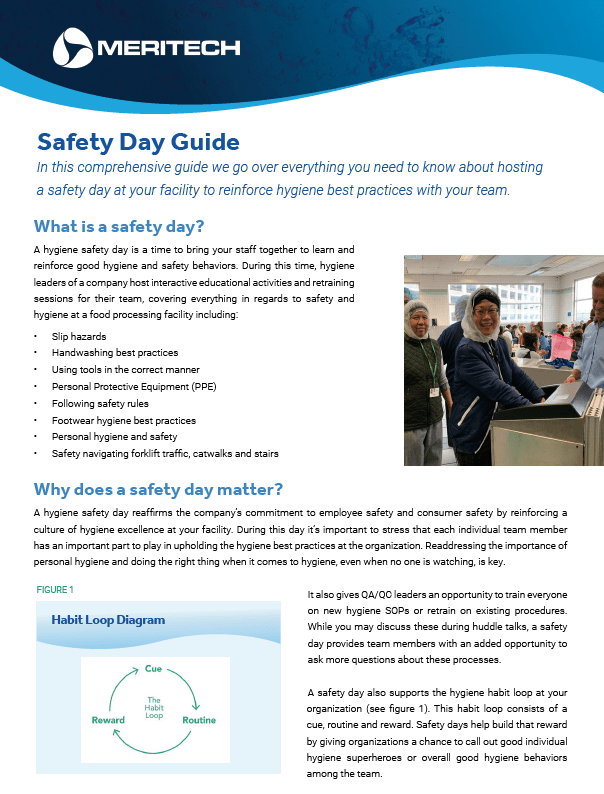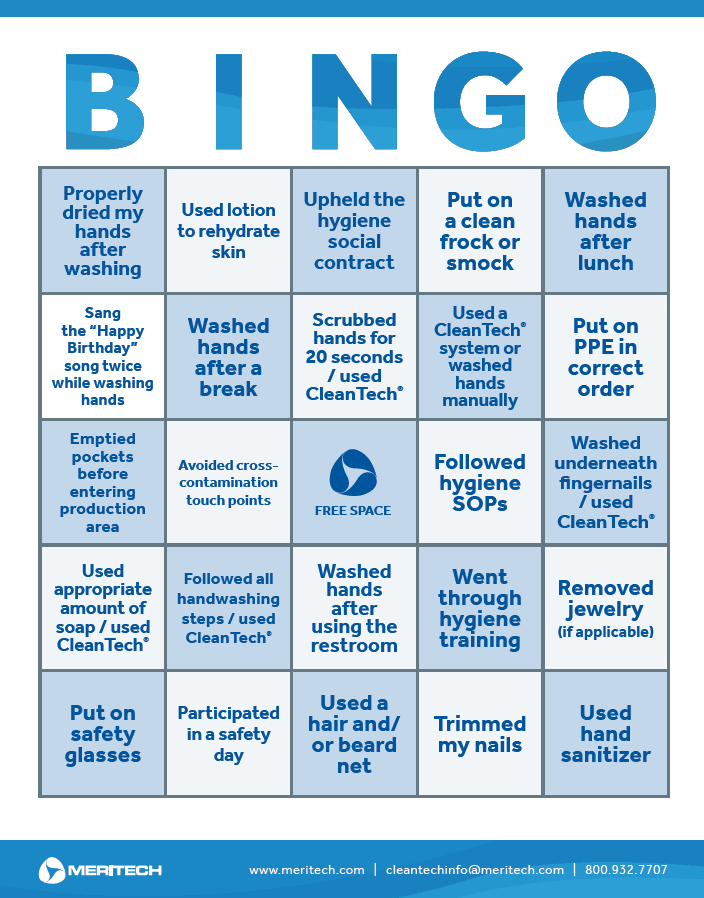How to Have a Successful Safety Day for Employee Food Safety Training
 What is a food safety day for employees? Why do these safety days matter for food safety training? Who participates in a safety day? We answer all these questions and give you the tips and resources you need to ensure hygiene best practices with your team when hosting your next safety day!
What is a food safety day for employees? Why do these safety days matter for food safety training? Who participates in a safety day? We answer all these questions and give you the tips and resources you need to ensure hygiene best practices with your team when hosting your next safety day!
Download our Comprehensive Safety Day Guide!
What is a safety day?
A hygiene safety day is a time to bring your staff together to learn and reinforce good hygiene and safety behaviors. During this time, hygiene leaders of a company host interactive educational activities and food safety training sessions for their team, covering everything in regards to safety and hygiene at a food processing facility including:
- Slip hazards
- Handwashing best practices
- Using tools in the correct manner
- Personal Protective Equipment (PPE)
- Following safety rules
- Footwear hygiene best practices
- Safety navigating forklift traffic, catwalks and stairs
- Personal hygiene and safety
Why does a safety day matter for employees?
A hygiene safety day helps demonstrate a company’s commitment to staff safety and the safety of consumers by reinforcing a culture of hygiene excellence at your facility. During this day it’s important to stress that each individual team member has an important part to play in upholding the hygiene best practices at the organization. Readdressing the importance of personal hygiene and doing the right thing when it comes to hygiene, even when no one is watching, is key.
It also gives QA/QC leaders an opportunity to train everyone on new hygiene SOPs or retrain on existing procedures. While you may discuss these during huddle talks, a safety day provides team members with an added opportunity to ask more questions about these processes.
Oftentimes employees only receive hygiene training during initial onboarding or during reinforcement training once a year. This results in peaks of behavioral compliance immediately after the training, but commonly employee compliance can soon after once employees return to normal behaviors. A safety day helps overcome this by building a good hygiene habit loop at your organization, keeping hygiene SOPs top of mind in between training events. This habit loop consists of a cue, routine and reward. Safety days help build that reward by giving organizations a chance to call out good individual hygiene superheroes or overall good hygiene behaviors among the team. This helps overcome those compliance pitfalls as you reinforce good hygiene behaviors often with your team vs. just during initial training and onboarding.
Who participates in a safety day?
Everyone at the facility should participate in the safety day. The goal of this day is to put everyone from managers to production team members on a flat line of leadership when it comes to hygiene. It’s important that everyone shows up and participates in food safety training activities, including executives and management to demonstrate the company’s commitment to hygiene and safety.
When should food manufacturing facilities have safety days?
Safety days should be held at least annually, but it ultimately depends on the facility and the capacity of those hosting the safety day(s). Hosting a safety day only once a year might be difficult if you’re dealing with a large number of employees and multiple shifts. It may be better to host a safety week with shifts having their team’s food safety training sessions at different times or on different days entirely to avoid major impacts to production.
When planning the date for your safety day, it’s also important to keep in mind trends at your facility. If accidents tend to occur more often around a certain time each year, or if seasonal labor is hired during peak season that may be the perfect time to have a safety day. By having a safety day during this time, you can retrain existing employees on safety best practices to avoid accidents and give new hires the food safety training and coaching they need to uphold the hygiene culture at your facility.
How to have a successful food safety day:
Here are some tips for a successful safety day at your facility:
Positively address safety and hygiene concerns
A hygiene safety day needs to be a positive day filled with reinforcement of good hygiene behaviors. While it’s critical to address safety incidents and hygiene concerns, rather than calling out certain shifts or teams, instead keep them anonymous and focus on what everyone can do as a team to prevent them from happening again.

Keep activities fun and interactive
Not only should everyone be involved on safety days, but they should be having a good time! Keep things positive using activities like hygiene day bingo, having a safety day champion, giving out participation t-shirts or recognizing good hygiene behaviors with hygiene superhero awards.
Download our hygiene bingo kit here!
Leverage your vendors
You don’t have to build a safety day alone, leverage your vendors to help build a successful safety day at your facility. For example, Personal Protective Equipment (PPE) vendors can demonstrate how to don and doff PPE properly. Also, if you’re using a captive footwear program, vendors can come in and make sure that the right footwear is available for staff and check employee footwear for wear and tear that could pose a safety hazard.
Meritech loves safety days! Our hygiene experts can help you organize and host a safety day at your facility. Not only can we reinforce food safety training sessions but can also demonstrate how CleanTech® Automated Handwashing Stations work and answer any questions from your team about our systems!
Learn More About Meritech’s Safety Days Here!






